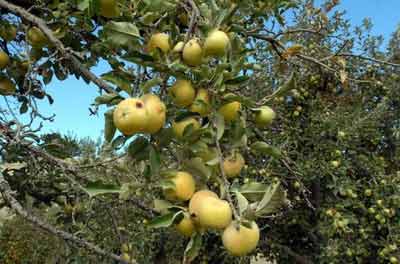|
 A piece of physicist Sir Isaac Newton's apple tree is to defy gravity by being carried into space on the next NASA shuttle mission. |
|
A piece of physicist Sir Isaac Newton's apple tree is to defy gravity by being carried into space on the next NASA shuttle mission. The 4-inch-long wood sample, which is normally held in the Royal Society archives in London, comes from the original tree from which an apple fell and inspired Newton's theory of gravity. Born in 1643 in Lincolnshire, Newton dominated British and European science by the early 1700s and is considered by many as the greatest scientist of his era. The tree sample along with a picture of Newton will be taken into orbit by British-born astronaut Dr Piers Sellers who will be part of a six-man crew aboard the NASA space shuttle Atlantis scheduled to lift off on May 14. "We're delighted to take this piece of Sir Isaac Newton's apple tree to orbit. While it's up there, it will be experiencing no gravity, so if it had an apple on it, the apple wouldn't fall," said Sellers. "I'm pretty sure that Sir Isaac would have loved to see this, assuming he wasn't spacesick, as it would have proved his first law of motion to be correct." After the flight the piece of tree and the picture of the scientist will be returned to the Royal Society. The mission is part of the academic institution's 350th anniversary celebrations. Newton himself was elected president of the Royal Society in 1703, an office he held until his death in 1727. Lord Rees, the current president of the Royal Society, said: "We are both pleased and proud that such an extraordinary part of scientific history and important element of the Royal Society's archive collection can make this historic trip into space. "Upon their return the piece of tree and picture of Newton will form part of the History of the Royal Society exhibition that the Society will be holding later this year and will then be held as a permanent exhibit at the Society," he added. (Read by Lee Hannon. Lee Hannon is a multimedia journalist at the China Daily Web site.) (Agencies) |
物理学家伊萨克•牛顿爵士的那棵苹果树上的一截树枝不久将随美国宇航局的宇航员们前往太空,体验零重力。 这截4英寸长的树枝现存于伦敦皇家学会档案馆,它来自那颗激发牛顿得出万有引力定律的苹果树。 牛顿于1643年出生于英国林肯郡,他在18世纪早期英国和欧洲的科学界占据重要地位,被很多人视为他那个时代最伟大的科学家。 这截树枝连同牛顿的一张画像将由英国出生的宇航员皮尔斯•塞勒斯博士带入太空。塞勒等六名宇航员将搭乘美国宇航局的亚特兰蒂斯号航天飞机于5月14日前往太空。 塞勒斯说:“我们很高兴能将伊萨克•牛顿爵士那颗苹果树上的树枝带入太空。那里没有重力,所以如果树上有苹果,也不会掉下来。” “我相信伊萨克爵士也很想见到这一切,当然如果他没有太空反应的话。因为这能证明他的第一运动定律的正确性。” 在飞行任务结束后,这截树枝和牛顿的画像将被送回皇家学会。 这项太空任务是英国皇家学会350周年庆祝活动的一部分。 牛顿于1703年被选为皇家学会主席,并一直担任该职,直到1727年去世。 皇家学会的现任主席李斯勋爵说:“珍藏于皇家学会档案馆的这件在科学史上具有非凡意义的重要物品能进行这次历史性的太空之旅,我们感到十分高兴和骄傲。” 他说:“从太空归来后,这截树枝和牛顿的画像将在学会将于今年晚些时候举行的皇家学会历史展上展出,并将成为皇家学会的永久展品。” 相关阅读 (中国日报网英语点津 陈丹妮 编辑蔡姗姗) |
